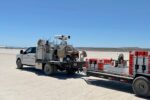Swiss aerospace firm SwissTo12 has acquired the intellectual property and key assets of UK-based Hanwha Phasor’s phased-array antenna business. The move signals a strategic expansion into flat panel satellite communications (SatCom) for both commercial and defense applications—particularly in Ka-band electronically steered arrays (ESAs). The acquisition strengthens SwissTo12’s vertically integrated approach to next-generation space systems using advanced additive manufacturing for RF payloads.
Strategic Acquisition Targets Flat Panel ESA Market
Announced in early June 2024, SwissTo12’s acquisition includes all of Hanwha Phasor’s antenna-related intellectual property and physical assets. This encompasses design files, test equipment, software-defined radio integration tools, and proprietary beamforming algorithms. Notably absent from the deal is the transfer of personnel; Hanwha Aerospace retains its engineering team but has exited the flat panel antenna market.
Hanwha Phasor had been developing dual-use active electronically steered antennas (AESAs) aimed at mobile platforms—such as ground vehicles and aircraft—that require robust Ka-band connectivity. Its technology featured low-profile flat panels with fast beam steering capabilities suitable for both commercial aviation IFC (in-flight connectivity) and military SATCOM-on-the-move (SOTM) use cases.
The acquisition positions SwissTo12 to enter a growing market segment dominated by players like Kymeta, ThinKom, Isotropic Systems (now All.Space), and Lockheed Martin. These systems are increasingly critical for resilient C4ISR architectures in contested environments where traditional parabolic dishes are vulnerable or impractical.
Defense Implications: Resilient SatCom-on-the-Move
Flat panel ESAs are gaining traction in military programs due to their low visual signature, high reliability (no moving parts), multi-beam support, and ability to dynamically switch between satellites—including LEO/MEO constellations like Starlink or OneWeb. These features align with NATO requirements for resilient beyond-line-of-sight (BLOS) communications under electronic warfare conditions.
Hanwha Phasor’s ESA architecture was designed for dual-polarization Ka-band operation with agile beamforming across wide scan angles. Such capabilities are essential for maintaining high-throughput links on mobile platforms like armored vehicles or airborne ISR assets operating in GPS/GNSS-denied or jammed environments.
For SwissTo12—already a supplier of RF subsystem payloads to European space agencies—the addition of this technology enables vertically integrated terminals that combine its proprietary 3D-printed waveguide structures with active beamforming electronics. This could result in lighter, more thermally efficient terminals suitable for tactical deployment on UAVs or land vehicles.
Additive Manufacturing Meets Active Beamforming
A core differentiator for SwissTo12 is its use of additive manufacturing—specifically selective laser melting—to fabricate complex RF waveguide geometries that outperform traditional subtractive designs in weight and thermal performance. The company has previously delivered such components to customers including Thales Alenia Space and the European Space Agency (ESA).
This expertise will now be applied to integrate Hanwha Phasor’s ESA front-end electronics with custom-designed feed networks and radomes optimized through 3D printing. The result could be a new class of modular terminals tailored for low-SWaP-C requirements across defense domains:
- Land: SOTM terminals mounted on command vehicles or UGVs
- Air: Low-profile conformal antennas on ISR drones or rotary-wing aircraft
- Sea: Compact terminals for small surface vessels or unmanned maritime platforms
The convergence of additive RF design with active beam steering also opens opportunities in electronic counter-countermeasures (ECCM), such as null steering against jammers or adaptive polarization techniques under adversarial conditions.
Diversifying Beyond GEO Payloads
This acquisition marks a significant diversification move by SwissTo12 beyond its traditional focus on geostationary orbit (GEO) payload components. Its flagship product line includes fully integrated RF payload modules used aboard commercial telecom satellites—but these are typically static systems optimized for fixed coverage footprints.
The integration of mobile ESA terminal technology allows SwissTo12 to address emerging demand from LEO/MEO constellation operators seeking high-performance user terminals that can operate across multiple orbital regimes. This aligns with defense trends toward hybrid space architectures combining commercial LEO capacity with sovereign GEO/MEO assets under protected MILSATCOM frameworks.
The company may now compete in NATO procurement programs such as ESSOR-compliant SATCOM terminals or contribute to pan-European initiatives like IRIS²—a secure EU satellite constellation project aimed at strategic autonomy in space-based communications.
Outlook: Toward Dual-Use Terminal Platforms
No financial terms were disclosed regarding the asset purchase from Hanwha Aerospace UK Ltd., but industry analysts suggest the deal reflects a broader shift among aerospace OEMs toward modularity and dual-use platforms capable of serving both civilian IFC markets and ruggedized military applications under one hardware baseline.
If successfully integrated into SwissTo12’s product roadmap by late 2024 or early 2025—as projected—the acquired ESA technology could yield deployable prototypes within NATO evaluation cycles by mid-decade. Key challenges will include radiation hardening of electronics for harsh environments, platform-specific integration constraints (e.g., vehicle roof curvature), and compliance with STANAG interoperability standards.
This move also underscores growing European interest in sovereign control over SatCom terminal supply chains amid geopolitical tensions affecting access to U.S.-based vendors like Viasat/Inmarsat or SpaceX Starshield offerings. By leveraging additive manufacturing within Europe alongside newly acquired IP rights from Hanwha Phasor, SwissTo12 may position itself as a strategic supplier within EU/NATO defense-industrial frameworks seeking autonomy over critical C4ISR infrastructure components.









